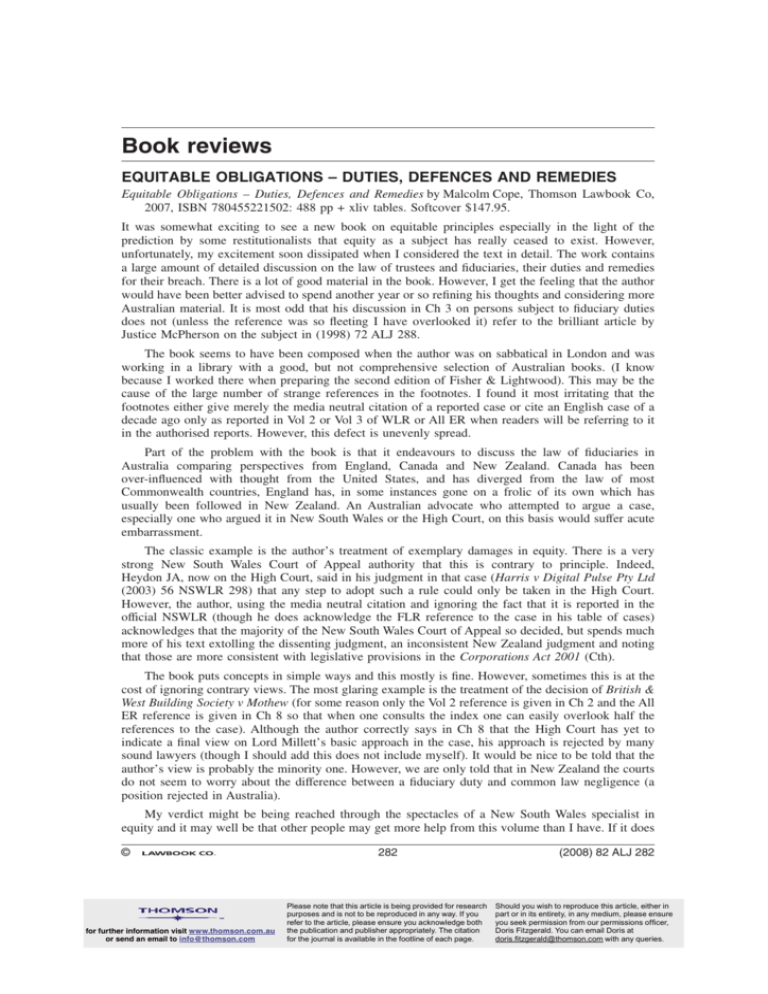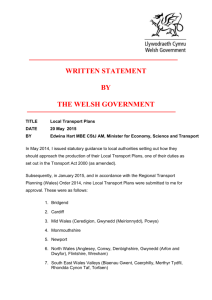Book reviews - Thomson Reuters
advertisement

Book reviews EQUITABLE OBLIGATIONS – DUTIES, DEFENCES AND REMEDIES Equitable Obligations – Duties, Defences and Remedies by Malcolm Cope, Thomson Lawbook Co, 2007, ISBN 780455221502: 488 pp + xliv tables. Softcover $147.95. It was somewhat exciting to see a new book on equitable principles especially in the light of the prediction by some restitutionalists that equity as a subject has really ceased to exist. However, unfortunately, my excitement soon dissipated when I considered the text in detail. The work contains a large amount of detailed discussion on the law of trustees and fiduciaries, their duties and remedies for their breach. There is a lot of good material in the book. However, I get the feeling that the author would have been better advised to spend another year or so refining his thoughts and considering more Australian material. It is most odd that his discussion in Ch 3 on persons subject to fiduciary duties does not (unless the reference was so fleeting I have overlooked it) refer to the brilliant article by Justice McPherson on the subject in (1998) 72 ALJ 288. The book seems to have been composed when the author was on sabbatical in London and was working in a library with a good, but not comprehensive selection of Australian books. (I know because I worked there when preparing the second edition of Fisher & Lightwood). This may be the cause of the large number of strange references in the footnotes. I found it most irritating that the footnotes either give merely the media neutral citation of a reported case or cite an English case of a decade ago only as reported in Vol 2 or Vol 3 of WLR or All ER when readers will be referring to it in the authorised reports. However, this defect is unevenly spread. Part of the problem with the book is that it endeavours to discuss the law of fiduciaries in Australia comparing perspectives from England, Canada and New Zealand. Canada has been over-influenced with thought from the United States, and has diverged from the law of most Commonwealth countries, England has, in some instances gone on a frolic of its own which has usually been followed in New Zealand. An Australian advocate who attempted to argue a case, especially one who argued it in New South Wales or the High Court, on this basis would suffer acute embarrassment. The classic example is the author’s treatment of exemplary damages in equity. There is a very strong New South Wales Court of Appeal authority that this is contrary to principle. Indeed, Heydon JA, now on the High Court, said in his judgment in that case (Harris v Digital Pulse Pty Ltd (2003) 56 NSWLR 298) that any step to adopt such a rule could only be taken in the High Court. However, the author, using the media neutral citation and ignoring the fact that it is reported in the official NSWLR (though he does acknowledge the FLR reference to the case in his table of cases) acknowledges that the majority of the New South Wales Court of Appeal so decided, but spends much more of his text extolling the dissenting judgment, an inconsistent New Zealand judgment and noting that those are more consistent with legislative provisions in the Corporations Act 2001 (Cth). The book puts concepts in simple ways and this mostly is fine. However, sometimes this is at the cost of ignoring contrary views. The most glaring example is the treatment of the decision of British & West Building Society v Mothew (for some reason only the Vol 2 reference is given in Ch 2 and the All ER reference is given in Ch 8 so that when one consults the index one can easily overlook half the references to the case). Although the author correctly says in Ch 8 that the High Court has yet to indicate a final view on Lord Millett’s basic approach in the case, his approach is rejected by many sound lawyers (though I should add this does not include myself). It would be nice to be told that the author’s view is probably the minority one. However, we are only told that in New Zealand the courts do not seem to worry about the difference between a fiduciary duty and common law negligence (a position rejected in Australia). My verdict might be being reached through the spectacles of a New South Wales specialist in equity and it may well be that other people may get more help from this volume than I have. If it does © for further information visit www.thomson.com.au or send an email to info@thomson.com 282 Please note that this article is being provided for research purposes and is not to be reproduced in any way. If you refer to the article, please ensure you acknowledge both the publication and publisher appropriately. The citation for the journal is available in the footline of each page. (2008) 82 ALJ 282 Should you wish to reproduce this article, either in part or in its entirety, in any medium, please ensure you seek permission from our permissions officer, Doris Fitzgerald. You can email Doris at doris.fitzgerald@thomson.com with any queries. Book reviews go into another edition in six years time or so, I hope that the author will build on the base of the material he has collected to make the work a more polished and comprehensive product than this first edition. PWY THE CHAMELEON CROWN The Chameleon Crown by Anne Twomey, Federation Press, 2006, ISBN 9781862876293: 304pp + xv tables. Hardcover $49.95. As the Hon Michael McHugh QC says in his foreword to this book, the concept of “the Crown” has been a chameleon-like institution that has protected itself by remaining in the background. This book examines the role that that institution has played in the Australian colonies and States from their foundation until recently. It goes into a detailed consideration of the relationship between the Australian States, the Queen and the United Kingdom Parliament. The dramas commence during the period of the first local government body, the New South Wales Legislative Council, set up in 1823 with seven members appointed by the King on the advice of British Ministers with no power to initiate legislation. In 1852, the New South Wales Governor warned the Foreign Office that there might be an American type revolution in New South Wales unless the British Government stopped vetoing local legislation and gave the local people control over Crown lands. The British Government ignored the warning, though it did give control over Crown lands to the locals late in the 1850s. The first six chapters deal with general historical matters including the appointment and removal of State Governors and the instructions given to them by the British Government. The remainder of the book focuses on the issues that arose, virtually for the first time in the Whitlam years and the consequences of the raising of those issues through to the passing of the Australia Acts. It is most interesting for those of us who lived through those years to see how what then happened was so significant for the settling of our constitutional relations both between our States and with respect to the British Crown. The book is replete with interesting details. For instance Mr Whitlam wanted the Queen to drop reference in her Australian title to her also being Queen of the United Kingdom, the title Defender of the Faith, the reference to her title being by the Grace of God, and to her being Elizabeth “the Second”, as he pointed out she was the only Elizabeth to have been Queen of Australia. Her Majesty agreed to drop the reference to the United Kingdom and to Defender of the Faith, but insisted on retaining the balance and in this she prevailed. As Michael McHugh says in his foreword, this is a splendid book. It opens up a host of constitutional matters which are not dealt with elsewhere and is extremely interesting general reading even to non-lawyers. The book was produced in conjunction with the Sesquicentenary of Responsible Government in New South Wales 1856-2006. PWY (2008) 82 ALJ 282 for further information visit www.thomson.com.au or send an email to info@thomson.com 283 Please note that this article is being provided for research purposes and is not to be reproduced in any way. If you refer to the article, please ensure you acknowledge both the publication and publisher appropriately. The citation for the journal is available in the footline of each page. © Should you wish to reproduce this article, either in part or in its entirety, in any medium, please ensure you seek permission from our permissions officer, Doris Fitzgerald. You can email Doris at doris.fitzgerald@thomson.com with any queries.







